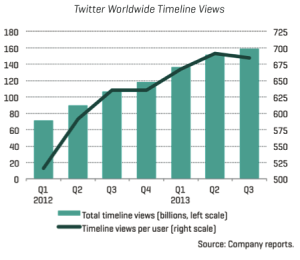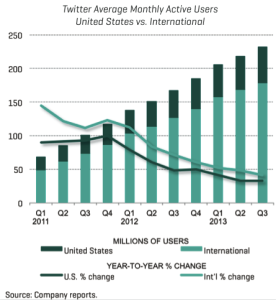Twitter’s business model appears to have shifted from being a network to being a destination. The question I address here, is whether this shift in strategy is going to work, and what the implications are.
Twitter’s Declining User Engagement: Can it be Solved?
There are two primary ways that consumers engage with Twitter:
- Posting to Twitter.
- Consuming Twitter timeline content.
We are only concerned with (2) — because that’s where ads are displayed in Twitter today.
The success of Twitter’s strategy depends on whether Twitter can build apps that really engage users consistently, and that grow timeline engagement.
The Twitter timeline is where ads are shown: it’s where the rubber meets the road for Twitter’s current strategy.
The evidence is only anecdotal at this point, but so far it appears that timeline engagement in Twitter’s timeline is in trouble.
According to Twitter’s own reports, timeline views per user are in decline.
This is an all-important metric of engagement and is a key metric to track in order to project whether Twitter’s app’s will succeed in capturing user attention.
If this metric continues to fall, Twitter’s ad business is going to be a tough road.
At the same time as the decline in timeline engagement, the US user growth rate for Twitter is also saturating, causing growth rates to decline.
For more on these metrics, see this article that details them further.
Assuming that total user growth is nearing the saturation point for Twitter, the company has to focus on mining its existing user base for more revenue.
To accomplish this, with their current strategy, they have to find ways to increase revenue per timeline view.
Only if Twitter succeeds in finding a way to capture more timeline attention from each consumer will it really grow and monetize its advertising network in the long-term.
But so far that’s not happening. In fact, anecdotally almost everyone I speak to reports they consume less timeline content on Twitter than they did a year ago, and this is reflected in Twitter’s macro engagement metrics.
Twitter’s UX Challenge
The underlying problem is that Twitter’s user-experience has drifted away from the original elegance and simplicity that made it popular.
Twitter used to be a fast way to get a succinct list of headlines from everyone you trust.
But in the Twitter UI/UX of today, it takes a lot of mental energy — and eyestrain — to plow through the timeline for the needles in the haystack.
Getting news efficiently out of Twitter apps today takes a lot of effort — you have to read through a lot of noise — like cards, embedded videos and photos, conversation threads, sponsored posts, and ads.
Due to large surface area of cards and expanded posts, there are fewer messages above the fold, meaning you have to scroll a lot more.
Scrolling takes more work and reduces engagement with content even further.
Ironically, the company that was able to hold an entirely irrational hard-line on the 140 character limit has not been able to hold nearly as firm a line on keeping their UI/UX simple.
In the last year we’ve witnessed increasing complexity in Twitter’s official app UI. It went from simple, understated and elegant to bloated and overbearing and confusing. It went from being Twitter to being more like Facebook.
That’s fine if Twitter is trying to emulate Facebook. But my understanding was always that Twitter was trying to Twitter, not Facebook.
Twitter was supposed to be the place to get short and easily consumable bursts of news from the world.
Part of the equation that made Twitter work was a simple UX that made getting news really fast and efficient: timelines comprised of simple short textual headlines were efficient to read and consume. Twitter has strayed far from that ideal today.
If Twitter can find a way to grow timeline attention per user, then advertising within Twitter could become a true sustainable growth business for Twitter long-term, and Twitter could maintain tight control of their channel. But that’s not looking likely right now.
If on the other hand, attention per user in Twitter continues to decline this means that advertising inside of Twitter will become an increasingly tough business proposition for Twitter and for Twitter advertisers.
Twitter will either need to steadily lower advertising prices and stuff their timelines with even more ads, or take some other drastic action in order to push their ads to consumers and make sure they get attention. That’s a race to the bottom.
How Can Twitter Win?
What happens if Twitter cannot grow timeline attention? Is there another way they could still win?
Yes! Twitter could still win, but it would require a massive shift in orientation.
Twitter could actually make more money from ads that Twitter runs outside of Twitter than inside it.
To do this Twitter would have to shift to becoming a retargeting network. Twitter would have to focus on monetizing their audience outside of Twitter apps and the official Twitter.com site.
Retargeting is already widely used online, notably by Facebook.
Twitter is sitting on a wealth of rich user profiles that could be used to target ads to their users on any sites and apps that use Twitter to OATH visitors.
Interestingly, there are tens of billions of impressions outside of Twitter across around a million third-party sites. Twitter is not monetizing these yet.
Furthermore, if Twitter reversed their ban on third-party consumer apps making use of Twitter data, and built out a retargeting network across them all, they could probably double or triple this number of outside impressions, and ad impressions, fairly rapidly.
There is a hidden opportunity here for Twitter to monetize as a network rather than as an app.
Of course this would be a bit of a reversal from Twitter’s previous position that monetizing Twitter outside of official Twitter apps is against the rules of the road.
If Twitter becomes a retargeting network then they will have to open the door to third-party apps again to fully tap the potential of this strategy.
How might Twitter amplify this even more?
- Make all their data free (with some rules) to third-party apps, sites and services to re-use.
- Require that third-party developers and service providers NOT modify Twitter content or insert their own ads.
- Require that third-party developers and service providers MUST carry only ads that come with it from Twitter.
- Twitter would also share revenues on any Twitter-provided ads with third-party apps that deliver impressions on those ads.
- Twitter’s ad network could use retargeting via Twitter profile data to provide highly personalized ads, generating better yields.
This is a killer strategy for Twitter and I’m willing to bet that someday they will return to it when they discover that monetizing only traffic inside Twitter isn’t going to generate enough growth.
Twitter-as-Network vs. Twitter-as-App
If Twitter was a network instead of an app, then in every ecological niche — every market niche — some third party developer or Webmaster would be able to figure out how to create a particular user experience that is best-optimized to squeeze out more engagement and attention per user within that niche.
That would enable Twitter to monetize the long-tail of attention. Twitter cold not possibly monetize all these opportunities with a generic solution as well as thousands of developers working, and competing, in parallel.
But instead of harnessing the power of the masses to optimize the long-tail, Twitter is making a bet they can monetize the entire channel better by themselves.
But is that even the best bet to make? The future value of owning the entire channel from end-to-end and controlling everything is not necessarily greater than the long-tail value of all the niches that Twitter has blocked by transforming from an open to a closed ecosystem.
The long-tail of Twitter advertising opportunities is worth more than owning just the head of the tail. It’s probably a better bet, if you just look at the statistics. It’s simply more likely to work in the long-run than betting that Twitter can build a generic solution that will succeed at being all things to all people.
A Better Endgame for Twitter
Twitter could in fact own both the head of the tail and the long tail opportunity. That’s the best of both worlds.
Twitter could have a strong portal and set of official apps PLUS an open content and advertising network that encourages third-party apps to drive even more attention to Twitter ads.
In this scenario, Twitter could encourage third-party consumer apps to compete to generate the most engagement and ad sales on Twitter data, in the new Twitter network.
They could even amplify that with a promise of cherry-picking the best performers of those and blessing them with massive traffic from Twitter’s central hub and maybe even investment funds or M&A for the best of them.
This would be the Twitter ecosystem 2.0, with new rules, and a built-in monetization system for everyone to partake in.
By re-opening the public APIs and even actively investing in third-party Twitter apps again, they could be been in a position to harvest outside innovation for the best new companies and ideas.
Thousands, or even millions, of apps and services generating timeline and ad impressions for Twitter is definitely a better way to grow their ad business than going it alone.
It’s not too late for Twitter to evolve their strategy around this issue, and if they don’t it’s pretty likely that Twitter advertising is going to be a tough sell in the long-run.


Pingback: Porqué Twitter no es la oveja negra | La Pastilla Roja
Pingback: Where Twitter Went Wrong and How to Right It | Nova Spivack - Minding the Planet